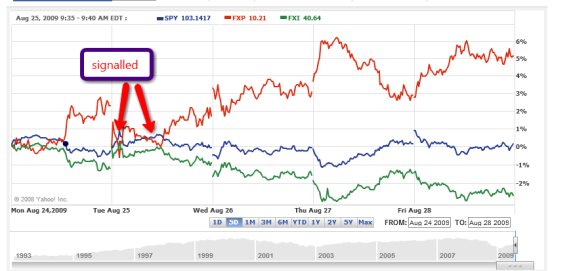 Normally at this time of year, bears are getting their stores in & looking at hibernation, but the recent market has turned that around, with bears dozing most of the summer & now waking up & looking hungry.
Normally at this time of year, bears are getting their stores in & looking at hibernation, but the recent market has turned that around, with bears dozing most of the summer & now waking up & looking hungry.
Followers of our Twitter account, will know that we have been taking a good look at China over the past 10 trading days & have a very bearish outlook on China going into the 3rd Quarter & by default on the S&P 500. Signals have been coming for a while with the BDI declining at an alarming rate from it’s June highs, flagging up the possibility that China’s economy & associated infrastructure drive are starting to run out of steam.
The Shanghai Composite has been steadily declining. losing in the region of 21% of its value in the last month, today the benchmark index slumped an eye boggling 6.75% at its close. This has prompted me to look at a trade that I have been thinking about for a few weeks, that is neatly hedged & could also be a home run as bearish sentiment hits the markets again.

Having looked at three well traded ETFs , we are placing a trade that is mixing it up a little with SDS :Ultra Short S&P 500, FXI :iShares FTSE/Xinhua China 25 Index & FXP ProShares UltraSh FTSE/Xinhua China 25. The following chart shows the last 5 trading days of SPY, FXI & FXP. As can be seen, there was a clear signal on Tuesday last, that there was a divergence in FXI / FXP, with the S&P 500 mainly trading sideways.

Now using the Morgan Stanley A Fund CAF as a sentiment monitor for the Shanghai market over the same period against SPY (NYSE: SPY), it would seem that there has been some pretty good correlation over the last 6 months of trading. For me CAF is one of the best tickers to use for real sentiment, as it trades in China A Shares, whilst FXI (NYSE: FXI) is predicated on 25 stocks traded on the Hong Kong market (mostly ADRs). From looking at the charts, it would appear that CAF (NYSE: CAF) actually front runs FXI by a two to three day period & this has helped me immensely in trading Chinese ADRs this summer. At the same time, SPY has followed the FXI trend reasonably faithfully for the last 3 months, until August 17th, when FXI began to dip.

So our feeling is that with China declining at such a rapid rate, Long FXP (NYSE: FXP) short FXI is a no brainer & we are looking to make some good returns over the next few weeks, we are also adding in a soupcon of SDS for interest & to confirm our bearish sentiment on the S&P 500. With a ratio of 2:1:1 we feel that this is a well hedged play, with a good upside potential.
We are looking to hold this trade for a minimum 10 day period & I have set this trade up on kaChing.com in our test account in order to track it. The idea being that we can give a visual on the performance of the trade & also a good term of reference when we close out the positions & reblog.
![Reblog this post [with Zemanta]](https://i0.wp.com/img.zemanta.com/reblog_e.png)

 Whilst suffering from shrinking export markets, led by the all important 20% supply of global copper, a shrinking economy & climbing unemployment; Chile continues to buck global trends, with ratings agency, Moody’s Investors Service making it the first investment- grade country to be awarded a higher credit rating this year. The South American country’s $22 billion of savings in wealth funds has put it in a position to recover more quickly from the global credit crisis than other, similarly rated nations, Moody’s said yesterday in raising Chile’s foreign debt to
Whilst suffering from shrinking export markets, led by the all important 20% supply of global copper, a shrinking economy & climbing unemployment; Chile continues to buck global trends, with ratings agency, Moody’s Investors Service making it the first investment- grade country to be awarded a higher credit rating this year. The South American country’s $22 billion of savings in wealth funds has put it in a position to recover more quickly from the global credit crisis than other, similarly rated nations, Moody’s said yesterday in raising Chile’s foreign debt to  With global copper prices sinking from a 2008 high of $4 per lb, down to todays miserly, $1.25 per lb, it is hardly surprising that the two major copper producing countries in South America are looking at ways to buoy up their operations. Last week, Peruvian president Alan Garcia dropped some strong hints that Peru & Chile should
With global copper prices sinking from a 2008 high of $4 per lb, down to todays miserly, $1.25 per lb, it is hardly surprising that the two major copper producing countries in South America are looking at ways to buoy up their operations. Last week, Peruvian president Alan Garcia dropped some strong hints that Peru & Chile should